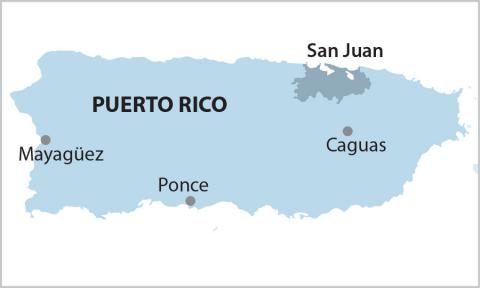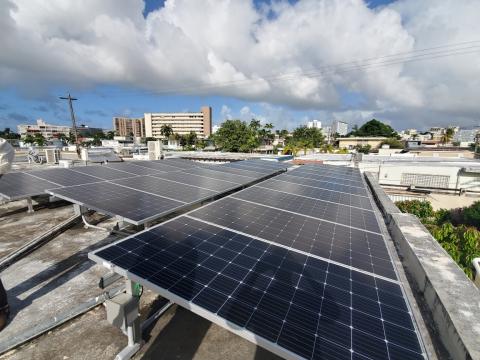New Puerto Rico bond deal: Another unsustainable transaction that makes matters worse

Key Findings
Puerto Rico electricity prices will remain among the highest in the nation.
The plan offers a $400 million bond to pay fees for advisors.
It includes unrealistic recovery rates of 60 to 84 percent for bondholders.
Puerto Rico regulators have learned little from past attempts to resolve the debt crisis.
The Puerto Rico Financial and Oversight Management Board (FOMB) has issued a plan to restructure the Puerto Rico Electric Power Authority’s $8.9 billion debt, using a combination of $5.4 billion in new bonds and sharp increases in the price of electricity over the next 35 to 50 years.
The board notes that the plan contains estimates, and readers “are cautioned not to place undue reliance on any of the financial information contained herein.” But the clearest conclusion that can be drawn from the plan is simple:
The price of electricity will go up.
The price of electricity will go up.
This is the fourth proposed deal (after two failed settlements and an aborted mediation settlement) to address the debt crisis of the electric authority, known as PREPA. The new plan shows that FOMB has learned very little from past failures.
The little that was learned, however, is worthy of mention. The plan exempts low-income residents from having to pay the majority of the rate increase, which would be structured as a flat monthly charge plus a rate for each kilowatt-hour (kWh) of electricity consumed. According to FOMB’s proposal, people who are poor are exempted from paying a flat fee and the rate on the first 500 kWh per month of consumption. IEEFA estimates that this constitutes more than 40% of Puerto Rico’s population.
This is the first time any proposed debt plan has acknowledged the inability of any portion of Puerto Rico’s population to pay.
Raising the price of electricity further when it is already among the highest in the nation, and the ratepayers are among the poorest, is not a solution.
The assumption is that the rest of the population would pay the entire bill for the debt over the next 35 to 50 years. If this is supposed to be a solution to PREPA’s debt problem—to put the grid on a firm financial footing and move PREPA toward market access—then this plan deserves the same fate as the first three plans. A careful review of the 400 pages of explanation and the 96-page plan tells us why this plan is unsustainable.
The disclosure statement tells us:
Despite PREPA’s failure to increase energy rates, a majority of respondents, in a June 2020 survey of PREPA’s customers, indicated that they were dissatisfied with the cost of electricity. On average, PREPA’s customers “pay more for electricity relative to their income than consumers in any U.S. state.”
Unpacking this statement reveals the underlying problems.
The plan does not address the operational 800-pound gorilla: The fuel budget.
First, the rates charged to consumers have not kept pace with either expenditures or debt costs. The point that PREPA historically failed to raise rates is presumed by the FOMB to be the result of a reckless political system. The failure to raise rates may reflect the recognition that Puerto Rico has a no-growth economy with a lot of low-income people. People who are poor will not buy electricity if they’re charged too much for it. Electricity is a basic necessity. To go without it is dangerous and unhealthy.
Second, how can people be paying more for electricity, relative to their income, than any state in the mainland U.S.? The price of electricity is currently at 28 cents/kWh and recently hit 33 cents/kWh, the highest price in the nation. The costs of fossil fuels that currently are the fuel of choice for PREPA management are driving the costs. When Russia invaded Ukraine, the price of electricity in Puerto Rico soared because the costs of oil and gas had skyrocketed.
Reductions in the fuel budget can be accomplished by implementing various approaches to solar energy.
Third, to raise the price of electricity further when it is already among the highest in the nation, and the people are among the poorest in the nation, is not a solution. IEEFA estimates that the plan could drive rates up between 4 cents and 8 cents per kWh depending on which financing method is chosen—a fact that is absent from the plan. This is a 14% to 28% increase in electricity at a time when the economy is not growing at all. To a customer, this money will simply pay back bondholders for debt incurred perhaps 20 years ago and now will be paid back for the next 50 years or more.
The documents outlining the new bond financing and subsequent increase in the price of electricity for ratepayers fail to take into account several points.
- The plan is economically unsustainable. The economy of Puerto Rico is a no-growth economy, and it will remain that way for the foreseeable future. High electricity prices will become a permanent part of the economic outlook. This bond deal will make the economic outlook weaker because future wage and profit growth must now go to pay back debt, an economically unproductive use. The deal, if approved, will mean that a system in fiscal distress will remain in fiscal distress. There are no facts in the 400-plus pages of disclosure that provide any evidence that the economy can support these increases.
- The price of electricity is unsustainable. The increase from the bond deal (the legacy charge) will consist of a flat fee and a charge against electricity use. IEEFA’s best guess is that rates will increase by between 4 cents and 8 cents per kWh. It is IEEFA’s best guess because the disclosure documents do not provide a projected rate plan. The plan’s credibility is undermined considerably by a failure to answer the basic question: How much will it cost people who have to pay the bill?
We note that the 2019 debt restructuring agreement—rejected precisely because it would have imposed unaffordable costs on the economy—would have imposed an average rate increase of 4 cents per kWh.
Our 8-cent scenario assumes the use of a capital appreciation bond and a set-aside of annual revenue to be paid at maturity. Of course, a capital appreciation bond could result in zero annual payments, leaving the final amount at maturity (some $36 billion) to the hope of rapid economic growth. The potential use of the capital appreciation concept is mentioned several times in the plan documents.
We also note the existence of a $400 million administrative bond that appears to cover fees for advisors.
- The operating assumptions are unsustainable. The disclosure document studiously describes the recent fiscal history of PREPA and the FOMB. It does not provide any analytical assessment of the results of that history. The document repeatedly refers to revenue and expense initiatives, but offers not a word about the lack of implementation success. Did the many initiatives, like the New Fortress Energy upgrade of the San Juan power station, actually result in planned savings to PREPA and its consumers? How were those savings used? There are literally hundreds of so-called savings initiatives that have been announced since 2017—the first year of FOMB’s operation—but not a word about outcomes. And yet, the disclosure tells us that in the future, PREPA and LUMA Energy, the island’s private grid operator, will have to implement major savings initiatives for the debt deal to work. There is no evidence that they are competent enough to achieve these goals.
- Fuel cost assumptions are unsustainable. The plan does not address the operational 800-pound gorilla: The fuel budget. The 2022 budget allocated almost $2 billion for fuel, 60% of the total $3.3 billion budget. The disclosure barely mentions the fact that if these expenditures are not substantially reduced, the new bond payments are unsustainable. According to a November 2022 letter to PREPA’s CEO, the agency still has difficulty controlling fuel costs. The disclosure hints at—but does not fully address—the active opposition by PREPA to the integration of substantial amounts of solar energy into the grid. Under current conditions, fossil fuel costs are unlikely to decline and this factor alone places budget balance at substantial risk.
- The plan is unsustainable and does not solve the problem. The adjustment plan should result in PREPA being placed on a track to become a going concern. But the document lacks credibility. The document should provide a description of the problems facing PREPA, the attempts to bring about solutions, progress made by those steps and what now needs to be done to continue that progress. The proposed deal should be related to those solutions.
It fails to achieve these basic goals.
For example, integrating renewable energy into the grid is not only environmentally sound but fiscally essential, a fact that has been recognized by all of the FOMB’s fiscal plans. But the interrelation between fossil fuel power sources, renewable energy and fiscal stability are all but ignored in this new plan. The only generation investment that has been brought to fruition is the San Juan project that now allows the plant to burn natural gas, a fossil fuel. Renewable energy projects are stalled or “forthcoming.” And the plan flat out admits that privatizing PREPA’s power plants will result in imported liquefied natural gas remaining a “primary” source of generation, with all the volatility and expense it entails. And, what does it mean that the regulator, the Puerto Rico Energy Board, has removed PREPA from control of the next round of renewable energy projects? The fact that 2,000 families per month are now opting to install solar systems is seen as a threat—and a reason to impose a flat monthly fee, rather than an exclusively volumetric fee, to pay back bondholders—instead of being welcomed as part of an urgently needed transition to renewable energy.
Reductions in the fuel budget can be accomplished by implementing various approaches to solar energy. Failure to meet renewables goals undermines the fiscal goals and substantially increases the likelihood of nonpayment of the new bond obligations. PREPA, and perhaps LUMA, seem set on undermining this critical fiscal and environmental goal.
- The plan is unsustainable and unable to meet the standards of third-party oversight.
It is highly questionable whether this deal can withstand any kind of external third-party review. As designed, the deal does not contemplate legislative or regulatory approval, although the judge may require it. The document also notes that the Puerto Rico Fiscal Agency and Financial Authority (AAFAF), the commonwealth’s fiscal agent, may impose conditions that could scuttle the deal.
Ramming this deal through without careful oversight will allow a closing to take place and ever-important bountiful paydays to occur for attorneys and accountants. They can skip town. When a problem occurs in the future, however, regulators and the legislature and governor have not bought into this plan; why should they bother to come to its rescue?
As designed, the transaction does not anticipate a request for a credit opinion from Moody’s, Standard and Poor’s or Fitch Ratings. Any of these entities could offer an unsolicited opinion. There are several reasons why they should:- There is a lack of transparency. As noted, announcements of reforms routinely fail to follow through with performance reporting. Perhaps the diligence of a credit-rating agency can unearth the facts about the current managerial stability of the grid. Despite noteworthy efforts, PREPA still does not have a current audited financial statement. Further routine requests for information by third parties go ignored.
- The transaction is designed to settle an estimated $8.9 billion in outstanding indebtedness claims. This is a bond deal of significant proportions. When the Long Island Power Authority settled the outstanding claims related to the Shoreham Nuclear power plant in 1997, the $7 billion in debt was considered the largest in history.
- The deal itself has several challenging features. The economy is weak. As designed, there is no support from regulators or the commonwealth government. Non-payment of the bond is not considered an event of default. There is highly questionable organizational capacity to execute the operations of the grid.
- There are significant policy issues related to the credit agencies. Moody’s, for example, has consistently stated that the recovery rate would be less than 35%. Depending on how the accounting is designed, the recovery rates range in this deal from 60% to 84%. The substantial discrepancy between Moody’s warnings and the proposed recovery rates in the latest plan should be examined and explained. Credit agencies received a substantial amount of criticism in the past for failing to call out financial risk. Here, they have offered a warning—and it appears to have been ignored.
- There is a lack of transparency. As noted, announcements of reforms routinely fail to follow through with performance reporting. Perhaps the diligence of a credit-rating agency can unearth the facts about the current managerial stability of the grid. Despite noteworthy efforts, PREPA still does not have a current audited financial statement. Further routine requests for information by third parties go ignored.
There are three obvious closing points that flow from this analysis.
- The document warns that readers “are cautioned not to place undue reliance on any of the financial information contained herein.” The disclosure statement speaks to a study commissioned by the FOMB by the law firm of Kobre and Kim. The report identified the commonwealth’s history of inadequate diligence and internal controls over debt. It appears the disclosure documents in PREPA’s case remain true to that tradition.
- The document also warns that raising the price of electricity is likely to result in fewer customers. The new plan exempts the poor from paying the extraordinary increases contemplated. While humanitarian in its impact, it is also practical since most island residents would have grave difficulty paying electricity prices of 30 to 35 cents per kilowatt-hour.
- In various places, the document encourages bondholders to consult tax counsel about certain complex tax questions. The likelihood of a future bankruptcy is high. The treatment of these bonds in such a process is probably another reason for investors to consult lawyers—and maybe even exercise a little independent common sense.
Tom Sanzillo ([email protected]) is IEEFA director of financial analysis

















